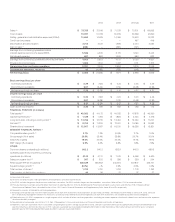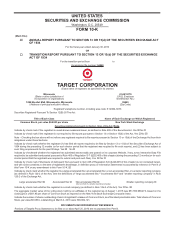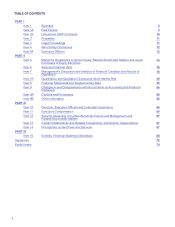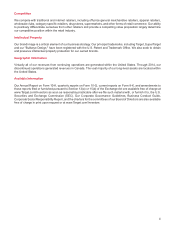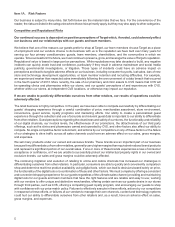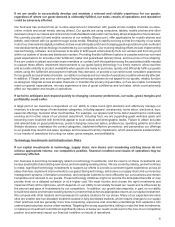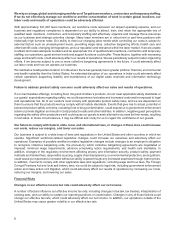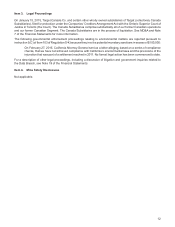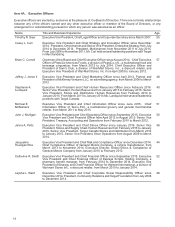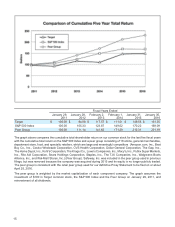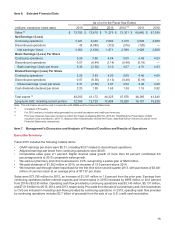Target 2015 Annual Report Download - page 14
Download and view the complete annual report
Please find page 14 of the 2015 Target annual report below. You can navigate through the pages in the report by either clicking on the pages listed below, or by using the keyword search tool below to find specific information within the annual report.
We rely on a large, global and changing workforce of Target team members, contractors and temporary staffing.
If we do not effectively manage our workforce and the concentration of work in certain global locations, our
labor costs and results of operations could be adversely affected.
With approximately 341,000 team members, our workforce costs represent our largest operating expense, and our
business and regulatory compliance is dependent on our ability to attract, train, and retain the appropriate mix of
qualified team members, contractors, and temporary staffing and effectively organize and manage those resources
as our business and strategic priorities change. Many team members are in entry-level or part-time positions with
historically high turnover rates. Our ability to meet our changing labor needs while controlling our costs is subject to
external factors such as unemployment levels, prevailing wage rates, collective bargaining efforts, health care and
other benefit costs, changing demographics, and our reputation and relevance within the labor market. If we are unable
to attract and retain adequate numbers and an appropriate mix of qualified team members, contractors and temporary
staffing, our operations, guest service levels and support functions could suffer. Those factors, together with increasing
wage and benefit costs, could adversely affect our results of operations. We are periodically subject to labor organizing
efforts. If we become subject to one or more collective bargaining agreements in the future, it could adversely affect
our labor costs and how we operate our business.
We maintain a headquarters location in India where there has generally been greater political, financial, environmental
and health instability than the United States. An extended disruption of our operations in India could adversely affect
certain operations supporting stability and maintenance of our digital sales channels and information technology
development.
Failure to address product safety concerns could adversely affect our sales and results of operations.
If our merchandise offerings, including food, drug and children’s products, do not meet applicable safety standards or
our guests’ expectations regarding safety, we could experience lost sales and increased costs and be exposed to legal
and reputational risk. All of our vendors must comply with applicable product safety laws, and we are dependent on
them to ensure that the products we buy comply with all safety standards. Events that give rise to actual, potential or
perceived product safety concerns, including food or drug contamination, could expose us to government enforcement
action or private litigation and result in costly product recalls and other liabilities. In addition, negative guest perceptions
regarding the safety of the products we sell could cause our guests to seek alternative sources for their needs, resulting
in lost sales. In those circumstances, it may be difficult and costly for us to regain the confidence of our guests.
Our failure to comply with federal, state, local, and international laws, or changes in these laws could increase
our costs, reduce our margins, and lower our sales.
Our business is subject to a wide array of laws and regulations in the United States and other countries in which we
operate. Significant workforce-related legislative changes could increase our expenses and adversely affect our
operations. Examples of possible workforce-related legislative changes include changes to an employer's obligation
to recognize collective bargaining units, the process by which collective bargaining agreements are negotiated or
imposed, minimum wage requirements, advance scheduling notice requirements, and health care mandates. In
addition, changes in the regulatory environment affecting privacy and information security, product safety, payment
methods and related fees, responsible sourcing, supply chain transparency, or environmental protection, among others,
could cause our expenses to increase without an ability to pass through any increased expenses through higher prices.
In addition, if we fail to comply with other applicable laws and regulations, including wage and hour laws, the Foreign
Corrupt Practices Act and local anti-bribery laws, we could be subject to legal risk, including government enforcement
action and class action civil litigation, which could adversely affect our results of operations by increasing our costs,
reducing our margins, and lowering our sales.
Financial Risks
Changes in our effective income tax rate could adversely affect our net income.
A number of factors influence our effective income tax rate, including changes in tax law, tax treaties, interpretation of
existing laws, and our ability to sustain our reporting positions on examination. Changes in any of those factors could
change our effective tax rate, which could adversely affect our net income. In addition, our operations outside of the
United States may cause greater volatility in our effective tax rate.
9


